Diving with Gobies
Lanta Marine Life | Gobiidae
The 'true gobies' represent more than 2,000 species and are one of the largest families of fish, representing almost 10% of all known fish species, with 10 - 20 new species discovered each year. Gobies are seen everywhere when diving from Koh Lanta.
Most gobies are small, with the vast majority less than 10cm, and some as small as 9 mm. A few larger species can reach over 30 cm in length, however this is unusual.
They have two separate dorsal fins, and as the pelvic fins develop, they fuse together to create a disc-shaped sucker which can be used to stick to rocks or corals.
Gobies are a bottom-dwelling fish, with some species of marine gobies building elaborate burrows, some living only in caves, others living inside sponges or on corals.
Both male and females often live in pairs, and like many other fish species, some members can change sex during their lives. What is unusual about some gobies is that they can change sex from female to male, and then back to female again. Other fishes can only undergo a single sex change.
10 species found on this page:
- Banded Goby (Amblygobius phalaena)
- Blueband Goby (Valenciennea strigata)
- Steinitz' Shrimpgoby (Amblyeleotris steinitzi)
- Barred Shrimpgoby (Cryptocentrus fasciatus)
- Twotone Dartfish (Ptereleotris evides)
- Spottail Dartfish (Ptereleotris heteroptera)
- Blotched Goby (Fusigobius inframaculatus)
- Signalfin Goby (Fusigobius signipinnis)
- Yellowstripe Goby (Koumansetta hectori)
- Striped Dwarfgoby (Eviota sebreei)
Banded Goby
(Amblygobius phalaena)
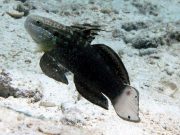
Amblygobius phalaena @ Koh Haa
The Banded Goby has several colour variations, ranging from a pale grey to dark brown body.
There are dark stripes on the head and forebody, and several darker bars toward the rear body. These stripes and bars may not be very clear on darker variations.
All variations have a black spot on the first dorsal fin. Most variations have a dusky spot on the upper tail, near the tail base, and a dark spot above the pectoral fin, close to the gill cover.
The Banded Goby grows to 13 cm, but usually observed around 10 cm or smaller, and can be found over sandy or rubble areas at the reef edge. This species feeds by gulping mouthfuls of sand from the seafloor and sifting out algae and invertebrates.
Blueband Goby
(Valenciennea strigata)
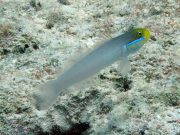
Valenciennea strigata @ Koh Haa
The Blueband Goby, or Bluestreak Goby has a white or grey body with a yellow face and snout. There is a bright blue stripe under the eye to the pectoral fin and several blue spots and markings on the head, gills and chin.
The Blueband Goby grows to 15 cm, but usually observed around 10 cm. This species is usually found in pairs over sand and rubble areas at the reef edge feeding by sifting mouthfuls of sand. The diet includes small invertebrates, fish, and fish eggs.
Steinitz' Shrimpgoby
(Amblyeleotris steinitzi)
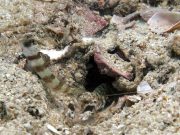
Amblyeleotris steinitzi @ Koh Haa
The Steinitz' Shrimpgoby has a white body with five vertical brown bars on the head and body. There are tiny yellow spots on both dorsal fins and on the upper body. There may be a very faint sixth bar, or blotch on the tail base. The iris is dark, or black.
Some variations of Steinitz' Shrimpgoby are very similar, but with much narrower body bars and a darker iris.

Steinitz' Shrimpgoby (Variation) @ Koh Haa
The Steinitz' Shrimpgoby grows to 8 cm and shares a burrow with one or more snapping shrimps of the genus Alpheus. These nearly-blind shrimp work tirelessly all day to excavate long burrows of up to one metre, and when above ground they always keep one antenna touching the goby tail to receive warnings of approaching danger.
The burrows run close to the surface and need to be continuously re-excavated due to collapse.
Barred Shrimpgoby
(Cryptocentrus fasciatus)
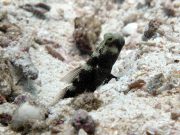
Cryptocentrus fasciatus @ Koh Haa
The Barred Shrimpgoby is variably coloured, and may have a pale body with four irregular brown bars, or a dark brown body with several whitish saddles on top of the head and along the back. Both variations have white or bluish streaks and spots on the head, forebody, pectoral and anal fins. The dorsal fin is unmarked.
The Barred Shrimpgoby grows to 8 cm and, similar to Steinitz' Shrimpgoby, shares a burrow with one or more snapping shrimps of the genus Alpheus.
The excavating shrimp create extensive burrows, with tunnels around 3 cm in diameter which connect 2 or 3 larger chambers within the network. Occasionally the goby will dart away from the burrow entrance to take a mouthful of sand which is sifted for food.
Twotone Dartfish
(Ptereleotris evides)

Ptereleotris evides @ Koh Haa
The Twotone Dartfish has a pale blue to greyish head and forebody, fading quickly to a very dark blue colouring on the rear body and second dorsal fin.
The tail is pale, forked and has dark margins. The gill covers may have small bright blue markings.
The Twotone Dartfish grows to 13 cm, but usually observed around 8 cm - 10 cm. This species lives in sandy burrows close to the reef edge and is almost always seen in pairs.
Spottail Dartfish
(Ptereleotris heteroptera)
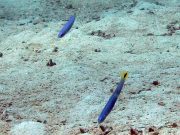
Ptereleotris heteroptera @ Koh Haa
The Spottail Dartfish has a long, thin, pale blue, or bluish grey body. The tail fin is yellow, with a large dark streak or spot in the middle.
The Spottail Dartfish lives over sand and rubble patches or hard substrates around the edges of a coral reef.
Adults are usually seen in pairs and share a burrow which is often under a rock or a piece of coral rubble. Occasionally several pairs are seen together.
Spottail Dartfish feed in pairs on zooplankton up to several meters above their burrow.
Blotched Goby
(Fusigobius inframaculatus)

Fusigobius inframaculatus @ Koh Haa
The Blotched Goby has a translucent body with many small orange spots on both the body and fins.
There are 4 - 5 large internal blackish blotches. The tail base has a white dash, followed by a black spot.
The first two dorsal spines are elongate and filamentous, especially in males, and less so in females.
The Blotched Goby grows to 7.5 cm and can be found over sand and coral rubble areas, though is rarely seen at the dive sites around Koh Lanta.
Signalfin Goby
(Fusigobius signipinnis)
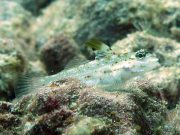
Fusigobius signipinnis @ Koh Haa
The Signalfin Goby has a translucent body covered with small brownish spots, white spots and dashes.
There is a red-brown to dark marking on the first dorsal fin, the 'signal'. The male has a taller, more heavily pigmented front dorsal fin.
The Signalfin Goby grows to 3 cm and is found over sand and rubble areas.
Yellowstripe Goby
(Koumansetta hectori)

Koumansetta hectori @ Koh Haa
The Yellowstripe Goby has a dark brown body with 4 bright yellow stripes.
There is a dark spot on the first dorsal fin, and a yellow edged black spot on the second dorsal fin and black spot on the upper tail.
The Yellowstripe Goby grows to 5 cm and is seen hovering over both live coral and coral rubble areas close to the reef.
Striped Dwarfgoby
(Eviota sebreei)
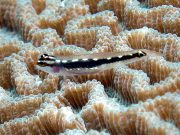
Eviota sebreei @ Koh Haa
The Striped Dwarfgoby has a translucent body and a prominent black internal stripe extending from the snout to tail fin base.
There are 8 small white blotches on the top of the dark internal stripe and the iris has a white stripe through its upper half.
The Striped Dwarfgoby grows to 25 mm (2.5 cm) and is often seen resting on live coral, sometimes in small groups.
Diving with Gobies around Koh Lanta
Scuba Diving & Snorkel Trips
If you'd love a chance to spot Gobies on one of our daily high season diving trips from Koh Lanta then send us an email to info@diveandrelax.com.
Join our high season speedboat dive trips to some of Thailand's best dive sites and enjoy small groups, short journey times, with a focus on great personal service, safety and fun.
Not yet a certified diver? Learn to Scuba Dive on Koh Lanta with the 3 day SSI Open Water Diver course.
Book online to save 10% on dive trips and scuba courses on Koh Lanta.
Find Out More
Indo-Pacific Marine Life Guides
- Allen, G., Steene, R., Humann, P., DeLoach, N. (2003) Reef Fish Identification, Tropical Pacific. Jacksonville, FL., USA: New World Publications, Inc., ISBN 1-878348-36-1.
- Humann, P., DeLoach, N., (2010) Reef Creature Identification, Tropical Pacific. Jacksonville, FL., USA: New World Publications Inc., ISBN 978-1-878348-44-9
- Debelius, H. (2013) Indian Ocean Reef Guide. Frankfurt, Germany: IKAN - Unterwasserarchiv, ISBN 978-3-939767-52-7.
- Debelius, H. (2004) Nudibranchs and Sea Snails, Indo-Pacific Field Guide. Frankfurt, Germany: IKAN - Unterwasserarchiv, ISBN 3-925919-51-1
- Erhardt, H., Knop, D. (2015) Corals Indo-Pacific Field Guide. Frankfurt, Germany: IKAN - Unterwasserarchiv, ISBN 3-925919-69-4.
- Veron J.E.N., Stafford-Smith M.G., Turak E. and DeVantier L.M. (2016). Corals of the World
